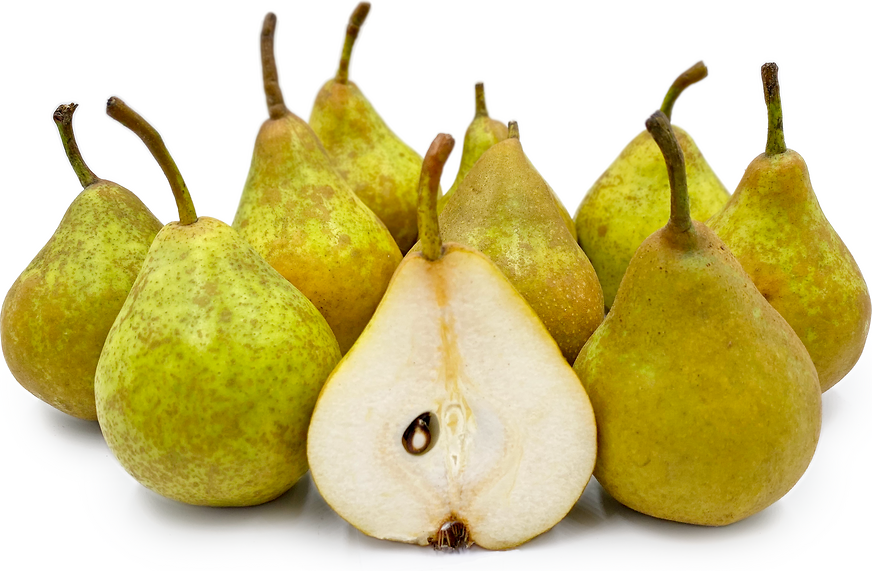


Gieser-Wildeman Pears
Estimated Inventory, lb : 0
Description/Taste
Gieser-Wildeman pears are small fruits, averaging 5 to 6 centimeters in diameter, and have a squat, bulbous base that slightly tapers to a rounded neck. The skin is very firm, ripening from green to yellow, and is sometimes covered in brown russet and red-orange blush. Underneath the surface, the flesh is ivory to white, coarse, aromatic, and moderately juicy, encasing a central core filled with small, black-brown seeds. Gieser-Wildeman pears, when raw, have a dense, grainy, and crunchy texture with a tart and tannic flavor. The fruits are preferably consumed when cooked and develop a sweeter taste with a soft, tender consistency.
Seasons/Availability
Gieser-Wildeman pears are available in the late fall through winter in Europe.
Current Facts
Gieser-Wildeman pears, botanically classified as Pyrus communis, are a Dutch cooking variety that belongs to the Rosaceae family. The very firm pear is often considered unpalatable when raw, due to its sharp flavor, but when cooked, the flesh softens and sweetens, transforming into a delicate side dish or dessert. Gieser-Wildman pears were named after the Giessen river in the Netherlands and are considered to be one of the most popular cooking pears within the country. The variety is especially favored as a side dish to wild game at Dutch restaurants, and the pears are often sold already peeled in a red wine sauce for quick applications. Outside of restaurants, Gieser-Wildeman pears are purchased through local markets for homemade stewed or poached pear dishes. Despite its fame in the Netherlands, Gieser-Wildeman pears are considered a rare variety outside of Dutch markets and are labeled as a specialty cultivar in select regions of Europe, such as the United Kingdom.
Nutritional Value
Gieser-Wildeman pears are an excellent source of fiber, which can help fuel healthy bacteria in the stomach and stimulate the digestive tract. The pears also contain some vitamins C, B6, and K, folate, potassium, calcium, magnesium, and iron.
Applications
Gieser-Wildeman pears are best suited for cooked applications such as stewing, baking, or poaching. The dense and firm fruits are traditionally cooked in red wine or sweet syrups to develop a soft and tender consistency. Once cooked, they are served as a side dish to roasted meats and vegetables, sliced and used as a topping on pizza, or used as a dessert served with ice cream. Gieser-Wildeman pears are also baked into scones, cakes, and tarts, or they are often wrapped in puff pastry, baked, and covered in a chocolate-espresso sauce. In the Netherlands, poached pears are known as stoofpeertjes and are traditionally served both hot and cold. There are many variations of poached pears using changing ingredients such as black currant liqueur, cloves, cinnamon, brown sugar, red wine, or lemon rind. Stoofpeertjes is treated similarly to a vegetable side dish when served with roasted meats and is a popular dish served at Dutch family gatherings. If any pears are remaining after a meal, they are repurposed into desserts the following day or are sliced and stirred into oatmeal and porridge for breakfast. Gieser-Wildeman pears are commonly served with meats such as rabbit, pheasant, beef, pancetta, and prosciutto, cheeses such as goat, parmesan, gorgonzola, and blue, boiled potatoes, honey, cranberries, arugula, thyme, rosemary, and nuts such as pecans, walnuts, and pistachios. The fresh fruits will keep 1-2 weeks when stored whole and unwashed in the crisper drawer of the refrigerator.
Ethnic/Cultural Info
In the Netherlands, poached Gieser-Wildeman pears are a favored dish traditionally served at Christmas and New Year’s dinners. The pears are peeled and cooked whole with the stems on for aesthetic appeal, and through the cooking process, the fruits develop a festive red hue. During the holiday season, poached pears are also an accompanying dish to gourmetten, which is a cooking method that places a small grill in the center of the table for guests to cook their own vegetables and meat. This cooking process is done in increments throughout the entire meal, and many different types of meats are consumed with side dishes such as sauces, baguettes, vegetables, and poached pears. In addition to home cooking, Gieser-Wildeman pears are famously known in the Netherlands as the logo and name for the Michelin starred restaurant, De Gieser Wildeman, located in Noordeloos, the Netherlands. Rumor has it that the head chef, Rene Tichelaar, highly favors the pear variety, which is why he named the restaurant after the fruit, and commonly serves the pear with ice cream as a dessert at the restaurant.
Geography/History
Gieser-Wildeman pears were first bred by Mr. Wildeman in the mid-19th century near the city of Gorinchem in the Netherlands. After their discovery, Van den Willik & Sons Nursery released the variety to commercial markets where they became widely popular as a cooking pear throughout the 20th century. Today Gieser-Wildeman pears are primarily localized to Dutch markets, but they can sometimes be found at markets in the United Kingdom, France, and Belgium.
Recipe Ideas
Recipes that include Gieser-Wildeman Pears. One
| By Andrea Janssen |
|
Poached Pears in Beer Sauce |




